Abstract
From a comparison of the effects produced by injecting different strains of Staphylococcus aureus either subcutaneously or intraperitoneally into normal, complement-deficient, or complement-depleted mice, it was possible to assess the pathogenic significance of various staphylococcal virulence factors and the defensive role of complement components in the two sites of infection. In skin lesions the inflammation-suppressing factor found in the cell walls of strain PS80 played a major role. In contrast, in intraperitoneal infection the antiphagocytic capsule of the Smith diffuse and M strains was more important. All strains used produced alpha-hemolysin, which is the ultimate lethal agent in intraperitoneal infection but is only one factor in the production of dermonecrosis. The severity of the skin lesions was inversely related to the amount of early fluid exudate rather than to the rate of bacterial growth, whereas in the peritoneum increased bacterial growth was associated with increased mortality. Both C3 and C5 were needed in the production of fluid exudate in response to staphylococcal skin infection. C3 appeared to be more important in the increased exudate formed in immune mice. In the peritoneum the opsonic and chemotactic actions for complement were important as shown by the results in cobra venom-treated normal mice and in C5-deficient B10D2 old-line mice.
Full text
PDF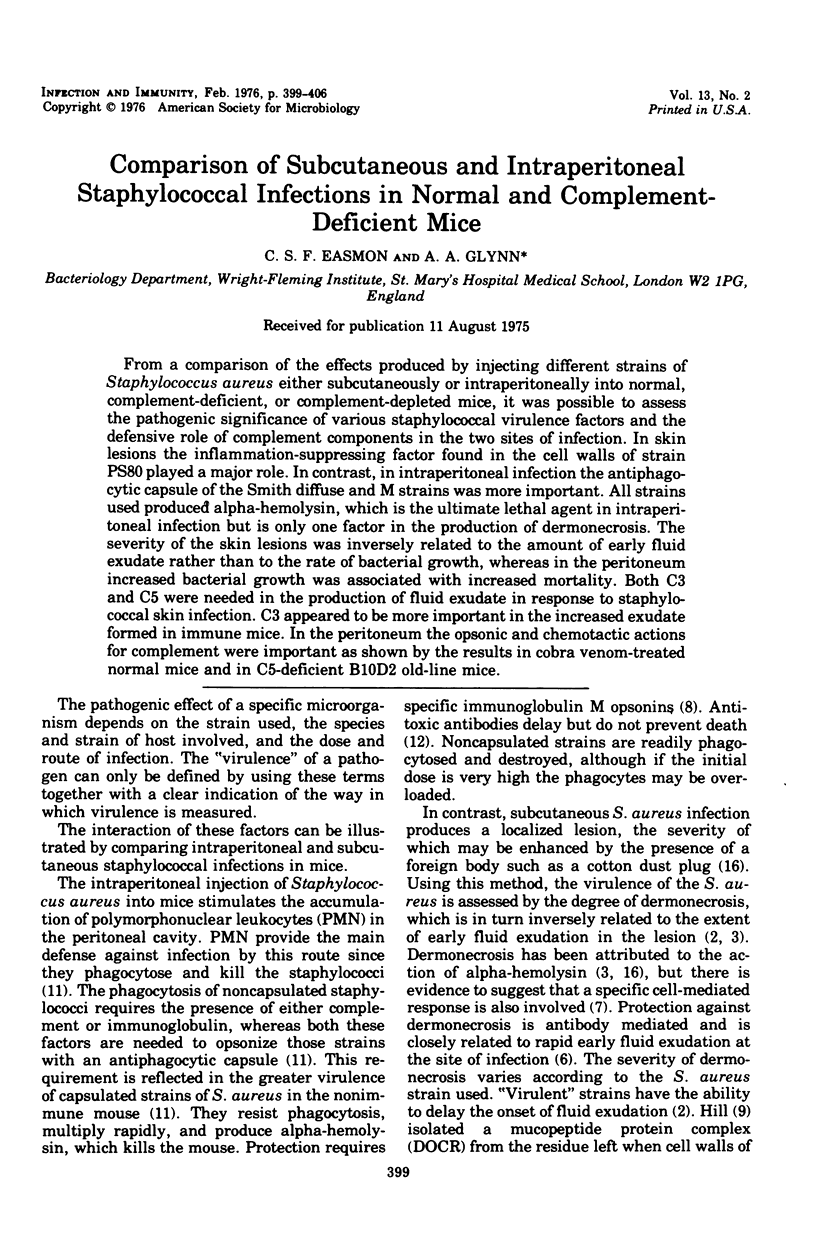
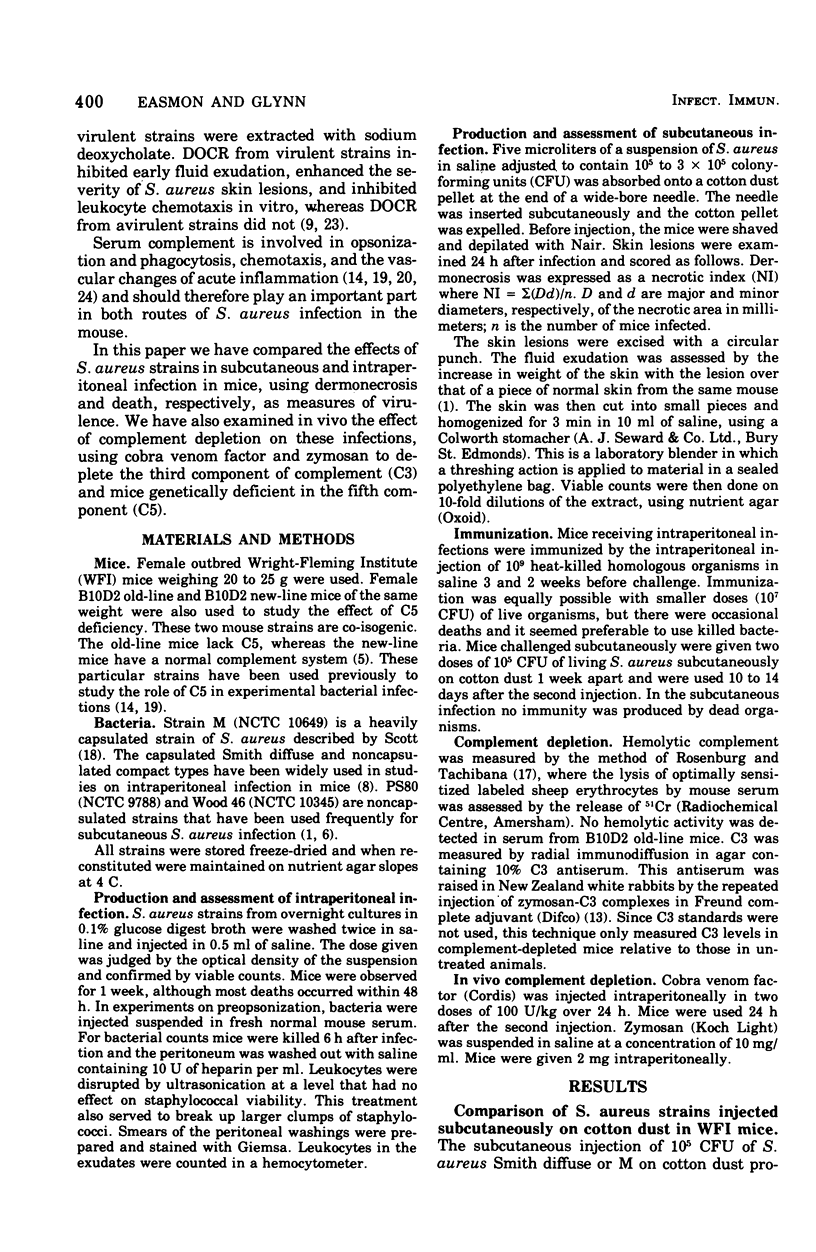
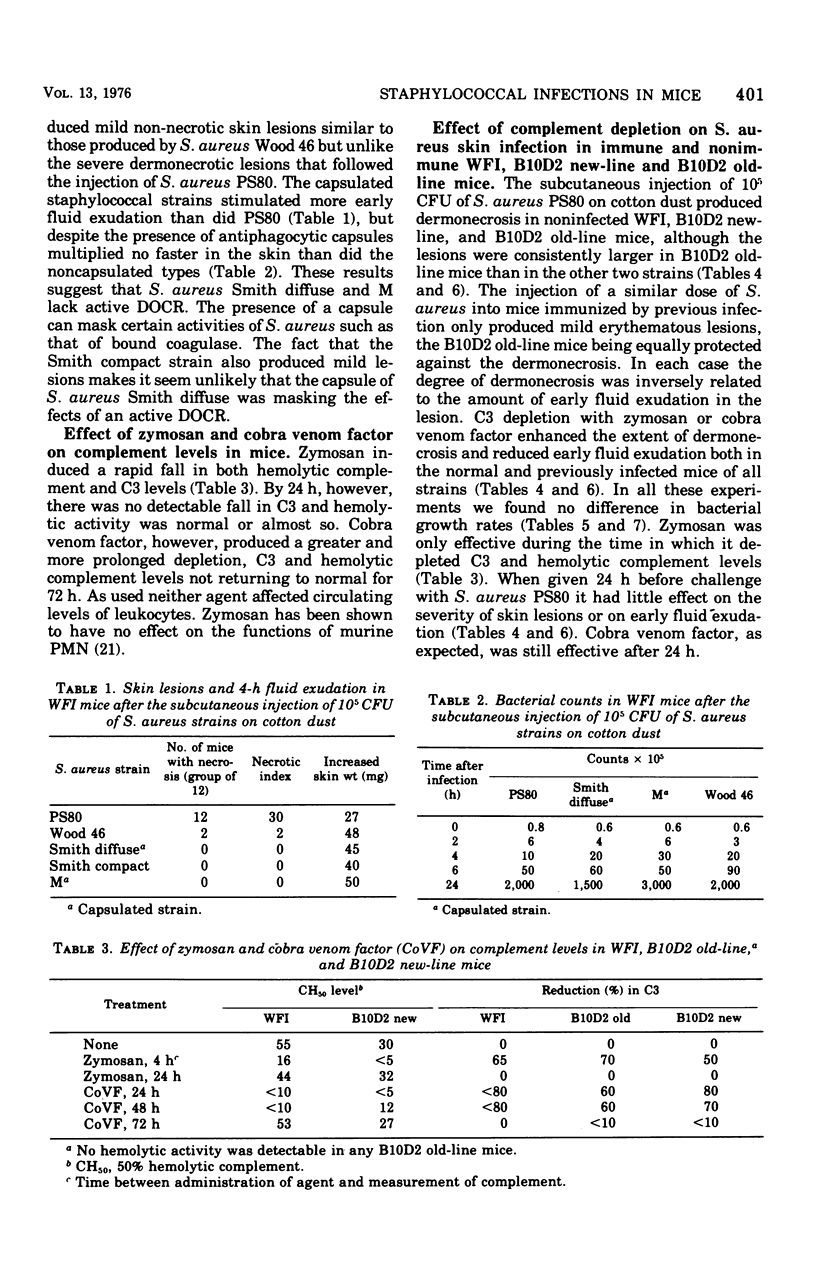
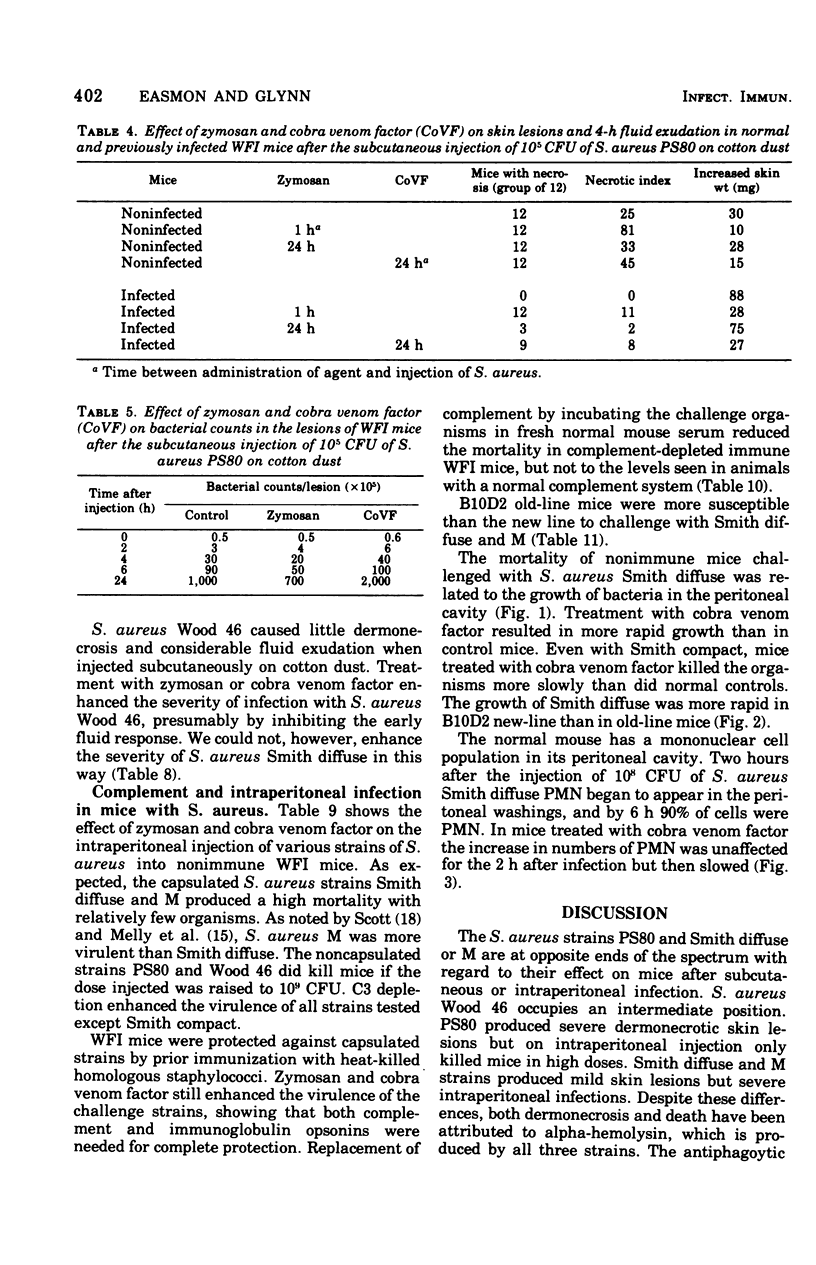
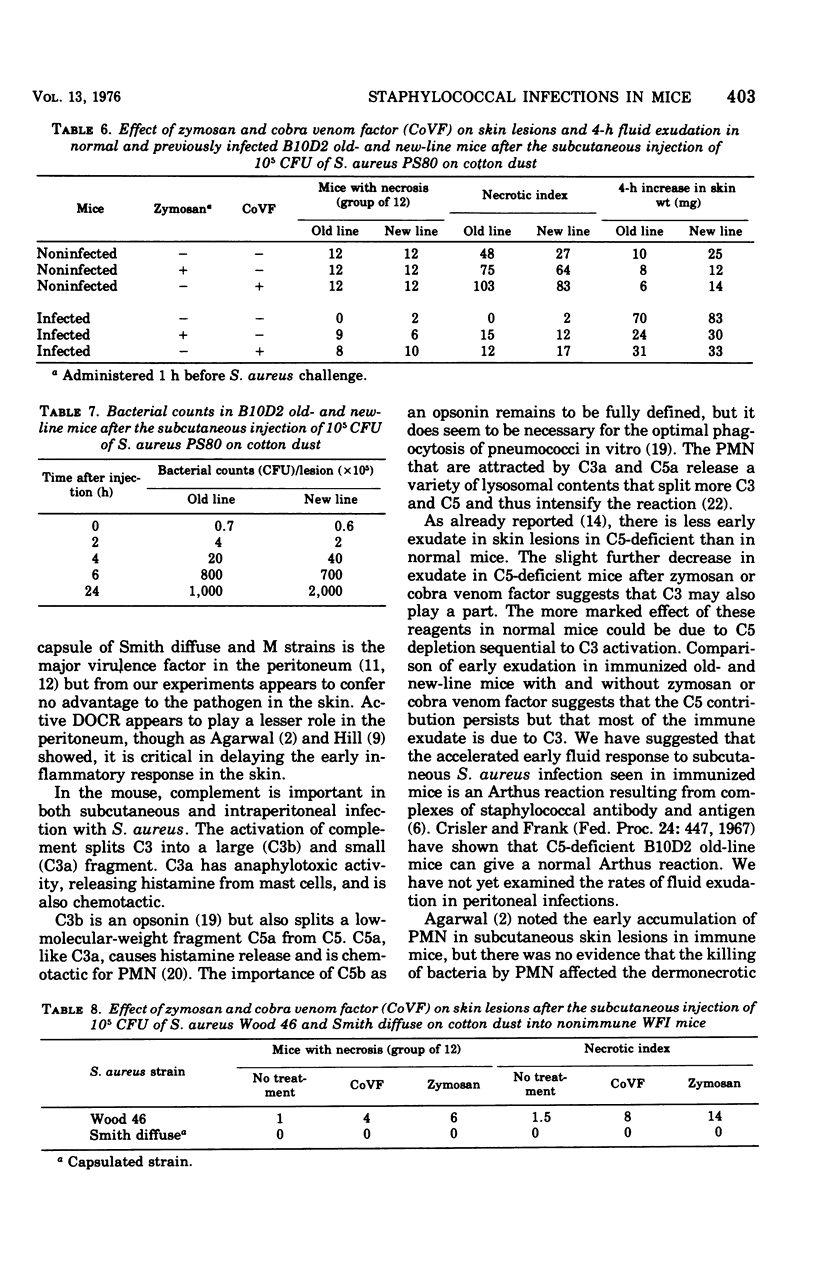
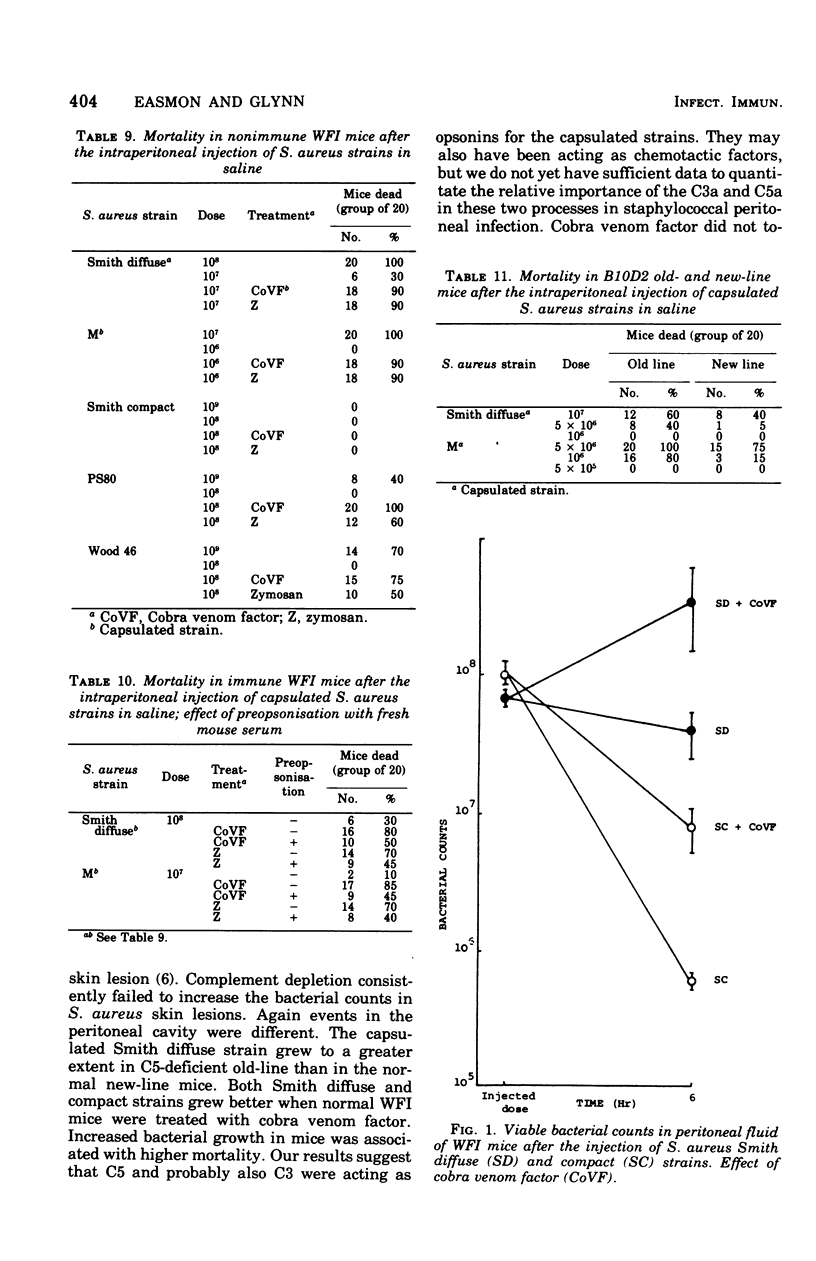
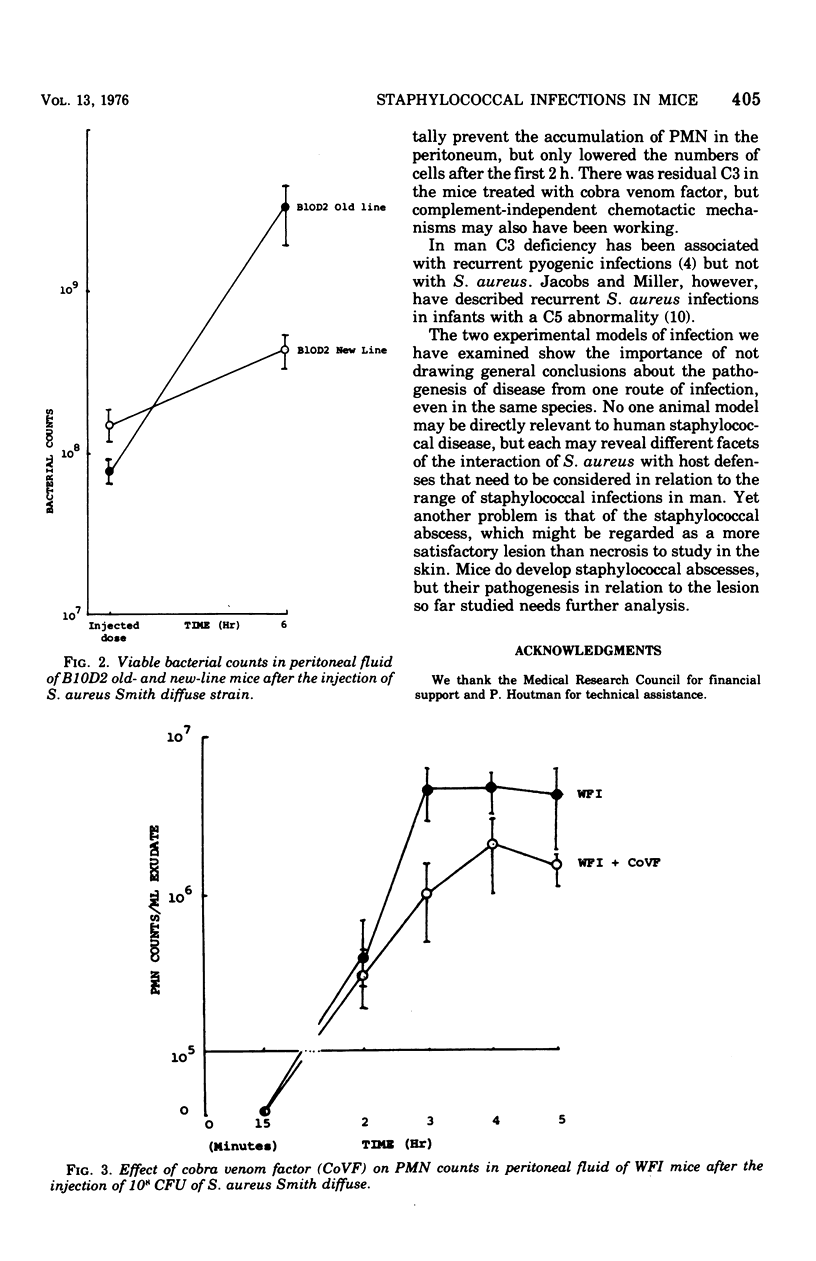
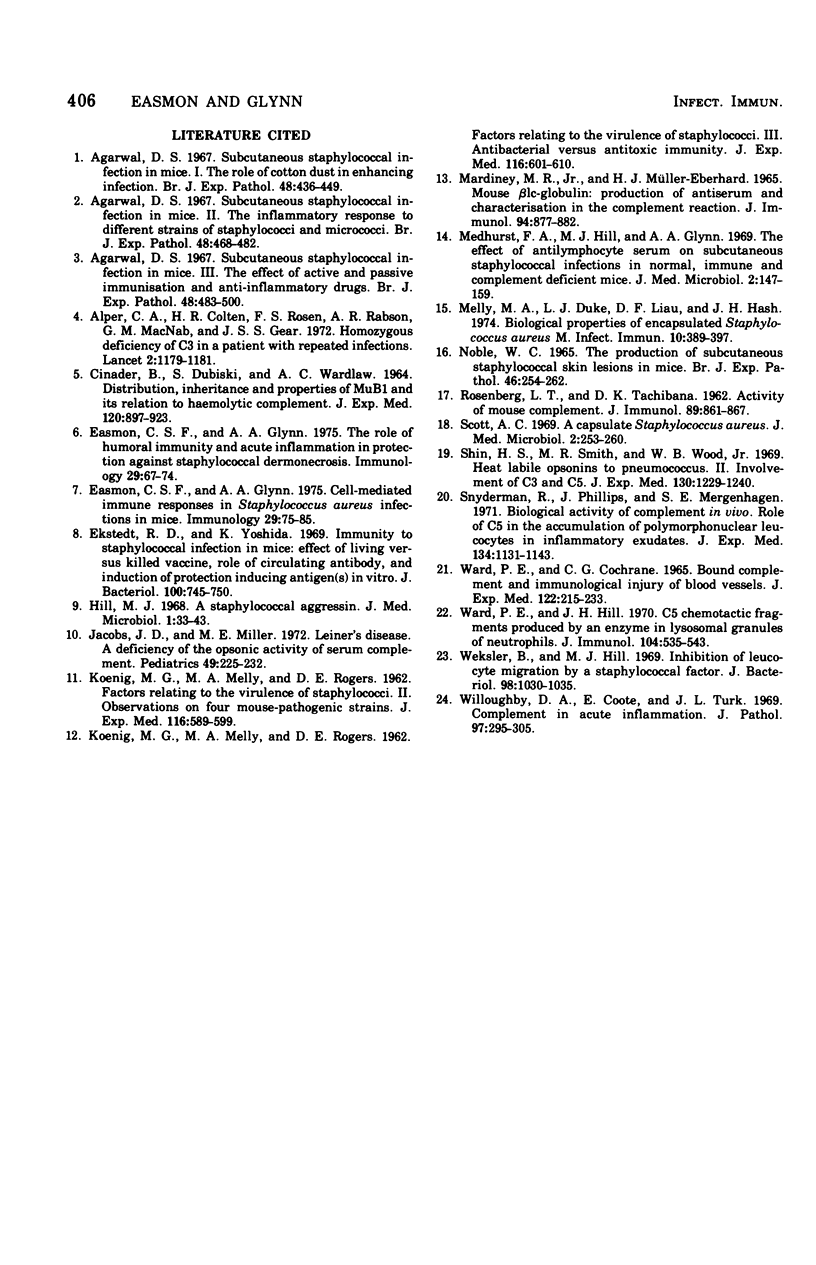
Selected References
These references are in PubMed. This may not be the complete list of references from this article.
- Agarwal D. S. Subcutaneous staphylococcal infection in mice. 3. Effect of active and passive immunization and anti-inflammatory drugs. Br J Exp Pathol. 1967 Oct;48(5):483–500. [PMC free article] [PubMed] [Google Scholar]
- Agarwal D. S. Subcutaneous staphylococcal infection in mice. I. The role of cotton-dust in enhancing infection. Br J Exp Pathol. 1967 Aug;48(4):436–449. [PMC free article] [PubMed] [Google Scholar]
- Agarwal D. S. Subcutaneous staphylococcal infection in mice. II. The inflammatory response to different strains of staphylococci and micrococci. Br J Exp Pathol. 1967 Oct;48(5):468–482. [PMC free article] [PubMed] [Google Scholar]
- Alper C. A., Colten H. R., Rosen F. S., Rabson A. R., Macnab G. M., Gear J. S. Homozygous deficiency of C3 in a patient with repeated infections. Lancet. 1972 Dec 2;2(7788):1179–1181. doi: 10.1016/s0140-6736(72)92598-6. [DOI] [PubMed] [Google Scholar]
- CINADER B., DUBISKI S., WARDLAW A. C. DISTRIBUTION, INHERITANCE, AND PROPERTIES OF AN ANTIGEN, MUB1, AND ITS RELATION TO HEMOLYTIC COMPLEMENT. J Exp Med. 1964 Nov 1;120:897–924. doi: 10.1084/jem.120.5.897. [DOI] [PMC free article] [PubMed] [Google Scholar]
- Easmon C. S., Glynn A. A. Cell-mediated immune responses in Staphylococcus aureus infections in mice. Immunology. 1975 Jul;29(1):75–85. [PMC free article] [PubMed] [Google Scholar]
- Easmon C. S., Glynn A. A. The role of humoral immunity and acute inflammation in protection against staphyloccocal dermonecrosis. Immunology. 1975 Jul;29(1):67–74. [PMC free article] [PubMed] [Google Scholar]
- Ekstedt R. D., Yoshida K. Immunity to staphylococcal infection in mice: effect of living versus killed vaccine, role of circulating antibody, and induction of protection-inducing antigen(s) in vitro. J Bacteriol. 1969 Nov;100(2):745–750. doi: 10.1128/jb.100.2.745-750.1969. [DOI] [PMC free article] [PubMed] [Google Scholar]
- Hill M. J. A staphylococcal aggressin. J Med Microbiol. 1968 Aug;1(1):31–43. doi: 10.1099/00222615-1-1-33. [DOI] [PubMed] [Google Scholar]
- Jacobs J. C., Miller M. E. Fatal familial Leiner's disease: a deficiency of the opsonic activity of serum complement. Pediatrics. 1972 Feb;49(2):225–232. [PubMed] [Google Scholar]
- KOENIG M. G., MELLY M. A., ROGERS D. E. Factors relating to the virulence of Staphylococci. II. Observations on four mouse-pathogenic strains. J Exp Med. 1962 Nov 1;116:589–599. doi: 10.1084/jem.116.5.589. [DOI] [PMC free article] [PubMed] [Google Scholar]
- KOENIG M. G., MELLY M. A., ROGERS D. E. Factors relating to the virulence of Staphylococci. III. Antibacterial versus antioxic immunity. J Exp Med. 1962 Nov 1;116:601–610. doi: 10.1084/jem.116.5.601. [DOI] [PMC free article] [PubMed] [Google Scholar]
- MARDINEY M. R., Jr, MUELLER-EBERHARD H. J. MOUSE BETA-1C-GLOBULIN: PRODUCTION OF ANTISERUM AND CHARACTERIZATION IN THE COMPLEMENT REACTION. J Immunol. 1965 Jun;94:877–882. [PubMed] [Google Scholar]
- Medhurst F. A., Hill M. J., Glynn A. A. The effect of antilymphocyte serum on subcutaneous staphylococcal infections in normal, immune and complement-deficient mice. J Med Microbiol. 1969 May;2(2):147–159. doi: 10.1099/00222615-2-2-147. [DOI] [PubMed] [Google Scholar]
- Melly M. A., Duke L. J., Liau D. F., Hash J. H. Biological properties of the encapsulated Staphylococcus aureus M. Infect Immun. 1974 Aug;10(2):389–397. doi: 10.1128/iai.10.2.389-397.1974. [DOI] [PMC free article] [PubMed] [Google Scholar]
- Noble W. C. The production of subcutaneous staphylococcal skin lesions in mice. Br J Exp Pathol. 1965 Jun;46(3):254–262. [PMC free article] [PubMed] [Google Scholar]
- ROSENBERG L. T., TACHIBANA D. K. Activity of mouse complement. J Immunol. 1962 Dec;89:861–867. [PubMed] [Google Scholar]
- Scott A. C. A capsulate Staphylococcus aureus. J Med Microbiol. 1969 Aug;2(3):253–260. doi: 10.1099/00222615-2-3-253. [DOI] [PubMed] [Google Scholar]
- Shin H. S., Smith M. R., Wood W. B., Jr Heat labile opsonins to pneumococcus. II. Involvement of C3 and C5. J Exp Med. 1969 Dec 1;130(6):1229–1241. doi: 10.1084/jem.130.6.1229. [DOI] [PMC free article] [PubMed] [Google Scholar]
- Snyderman R., Phillips J. K., Mergenhagen S. E. Biological activity of complement in vivo. Role of C5 in the accumulation of polymorphonuclear leukocytes in inflammatory exudates. J Exp Med. 1971 Nov 1;134(5):1131–1143. doi: 10.1084/jem.134.5.1131. [DOI] [PMC free article] [PubMed] [Google Scholar]
- WARD P. A., COCHRANE C. G. BOUND COMPLEMENT AND IMMUNOLOGIC INJURY OF BLOOD VESSELS. J Exp Med. 1965 Feb 1;121:215–234. doi: 10.1084/jem.121.2.215. [DOI] [PMC free article] [PubMed] [Google Scholar]
- Ward P. A., Hill J. H. C5 chemotactic fragments produced by an enzyme in lysosomal granules of neutrophils. J Immunol. 1970 Mar;104(3):535–543. [PubMed] [Google Scholar]
- Weksler B. B., Hill M. J. Inhibition of leukocyte migration by a staphylococcal factor. J Bacteriol. 1969 Jun;98(3):1030–1035. doi: 10.1128/jb.98.3.1030-1035.1969. [DOI] [PMC free article] [PubMed] [Google Scholar]
- Willoughby D. A., Coote E., Turk J. L. Complement in acute inflammation. J Pathol. 1969 Feb;97(2):295–305. doi: 10.1002/path.1710970215. [DOI] [PubMed] [Google Scholar]


